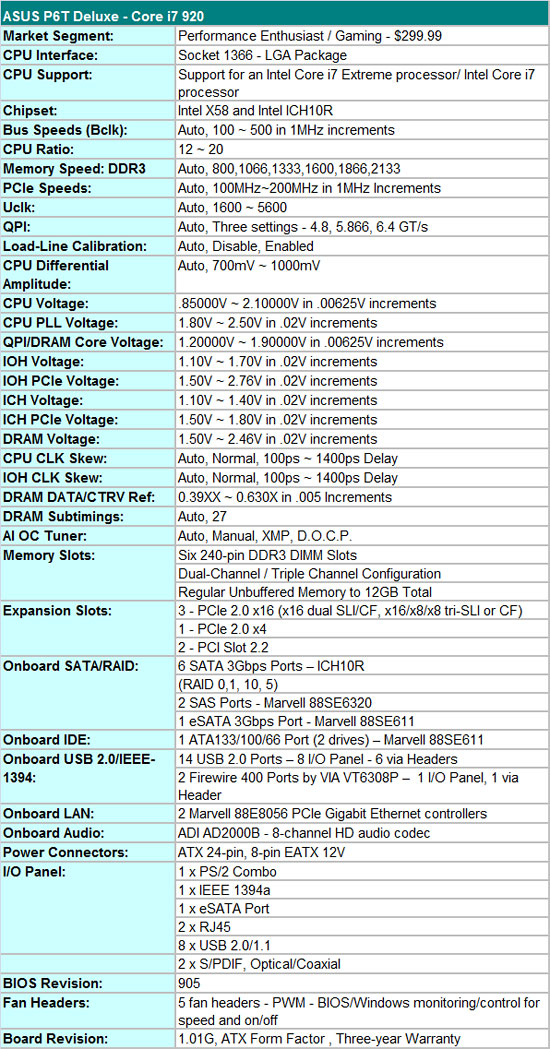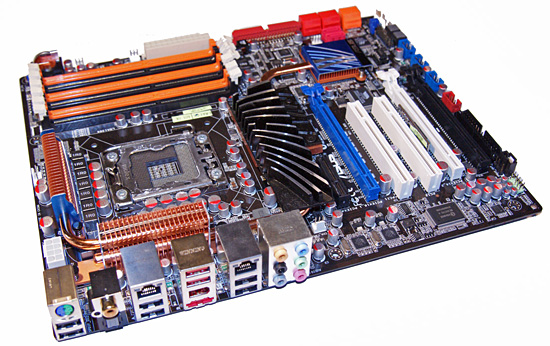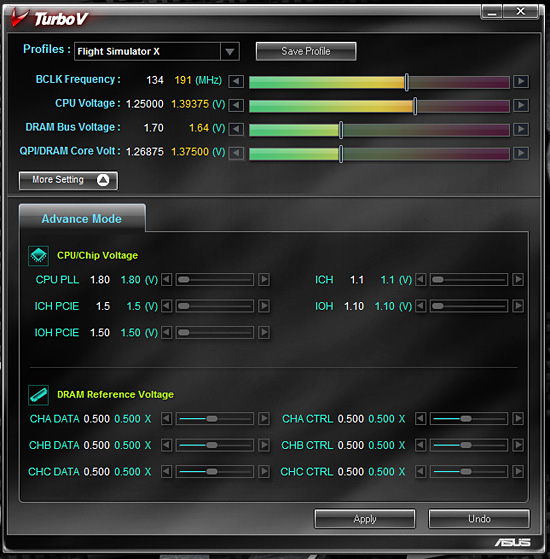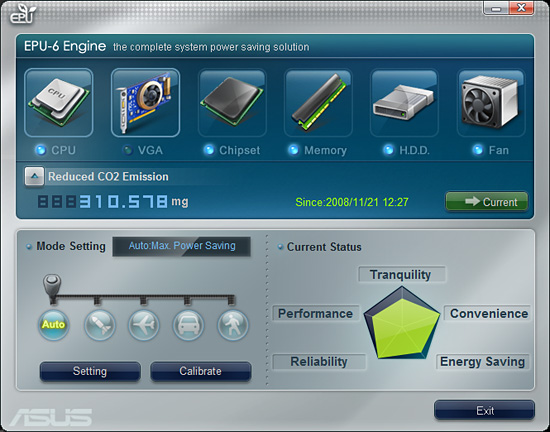Intel X58 Motherboard Roundup - What does $300 Get You?
by Gary Key on December 5, 2008 3:00 PM EST- Posted in
- Motherboards
ASUS P6T Deluxe
Features

ASUS offers the P6T Deluxe in two different versions, one with the OC Palm external display module for $338 and one without for $299. The OC Palm was originally introduced as the ScreenDuo last year and features a 2.5" QVGA display, four-way directional pad, and four input buttons. It attaches to the motherboard via a USB cable and features a clean, uncluttered, and simplistic interface that allows the user to interface with various ASUS software programs. The user can monitor various hardware functions or do on-the-fly overclocking. The unit allows real-time changes to the processor's Bclk along with voltages for QPI, memory bus, and the CPU. We would like to see additional overclocking variables along with the ability to save profiles to the BIOS or real-time changes to the BIOS. Overall, it is a unique feature and fun to play with for about 30 minutes, but for most users we would suggest saving the money and buying the base board - A board that we might add is one of our favorites in the lab since it first arrived.
Not to take anything away from our other boards as they are all very good with one bordering on being great, but the ASUS P6T-Deluxe impressed us with its ability to just work as expected out of the box. While we provided several suggestions to ASUS for improvements, they mainly centered on tuning aspects, not getting basic functions to work properly before we could even consider testing. That may seem trivial, but unfortunately it is not if you are an early adopter of high-end motherboards.
The BIOS is designed for a wide variety of users who want to get the most out of a board when overclocking. Some of the voltage ranges are not as wide as Gigabyte's, nor do you have the ability to control each individual memory channel, but the options available will more than suffice for most users. We also think the ASUS BIOS is more user friendly due to the information provided for each option. However, ASUS continues to use the terminology QPI/DRAM instead of VTT as the other boards do.
ASUS features memory speeds from 800MHz to 2133MHz memory for the i920/i940 processors along with opening up QPI link speeds from a standard 4.800 GT/s up to 6.400 GT/s. We are disappointed with the number of OC profiles in the BIOS. ASUS has three OC profiles compared to up to eight on the other boards.
The board officially supports 12GB of DDR3 memory, although we expect full support for 24GB in a future BIOS release. Running 12GB of memory on this board is extremely easy and it usually requires less voltage while providing tighter timings than the other boards. Our 12GB Patriot and G.Skill DDR3-1600 kits were 24/7 stable at 1600 with 8-8-8-24 1T timings, although we needed about 1.66V for absolute stability. The Gigabyte board offered slightly better latency results with 9-8-8-24 1T timings, but the ASUS board was just slightly faster in most of the benchmarks except for WinRAR. Of course, your mileage will vary with different memory kits and sub-timings, and outside of memory benchmarks the net difference is generally less than 1%.
One last item of note, at least in this first look, is that the three PCI Express 2.0 x16 slots will operate in x16/x16 mode for 2x SLI/CF if the third x16 slot is empty. If you decide to place a PCIe RAID, network, audio, or TV tuner card in the third x16 slot, then the 2x SLI/CF configuration will operate in x16/x8 mode. We did not notice any performance differences between the two modes with our HD 4870 or GTX 260 cards. 3x SLI/CF configurations will run in x16/x8/x8 mode. You can also use the first and third x16 slots for graphics if you need to open up a PCI slot but the board will run in x16/x8 mode. Although the owner’s manual states the three x16 slots are for graphics cards only, we had no problems running our ASUS Xonar D2X or Highpoint Rocket RAID cards in x16 slot two or three.
The Board


The P6T Deluxe carries over the orange and black decor from previous ASUS DDR3 boards along with a blue and white slot motif. While not exactly as colorful as previous Gigabyte boards or as subdued as the MSI board, it does work well enough; we prefer the flagship ROG color palettes. ASUS has constantly improved their layouts over time and the P6T Deluxe reflects this with a design that is virtually free of clearance problems. While not as loaded as the Gigabyte board, ASUS still has a substantial amount of items to squeeze onto the motherboard.
The first item we notice on the P6T Deluxe is the heatsink and thermal pipe setup encircling the CPU socket area. The CPU socket is centered to the DIMM slots as we noticed on the Gigabyte board. The engineers tell us this is to optimize the memory trace paths resulting in higher overclocks and improved stability. The various heatsinks are low-profile designs featuring a completely passive setup in order to keep noise to a minimum. ASUS utilizes a swept fan design for the northbridge, a small but effective fin array for the ICH10R, and a couple of relatively low-profile fin arrays for the PWM area.
All of this equates to a CPU area that is basically void of clearance issues with large air coolers, although the capacitors are little close to the 1366 socket for the more extreme cooling options. The P6T Deluxe features 23 power phases, which certainly sounds impressive, but we are still not sure if quantity is better than quality in this regard. ASUS dedicates 16 for the processor core and another three memory, two each for the memory/QPI controller and chipset. The Gigabyte and MSI boards feature two individual two-phase designs for the memory and QPI systems.
On the other end of the board we have a bevy of SATA ports and the IDE connector. The six red ports are tied to the ICH10R while the two orange ones attach to a Marvell 88SE6320 Serial Attached SCSI controller. Backwards compatibility built into the SAS standard allows current SATA drives to work. When utilizing a standard SATA drive, performance is close to the ICH10R and definitely a step ahead of the JMicron controllers on the other boards. As a plus, it will do RAID 0 and 1 arrays, and ASUS includes SAS cables in the box. We appreciate the right angle connectors as they ensure there will not be any clearance issues with longer cards. However, ports 5 and 6 use a standard design that results in a very tight fit with a couple of GTX280s installed.
ASUS includes onboard power and reset buttons, but curiously forgot to include a clear CMOS button. After weeks of testing, it is a feature we miss, even though ASUS' BIOS recovery system rarely let us down. Moving forward, we have three physical x16 slots available for graphics in a x16/x8/x8 configuration with a 3X setup. In order to run a 3X setup, the second GPU will have to be a single slot solution... which sort of defeats the purpose of 3-way support, since the current NVIDIA 3-way SLI cards are all dual slot solutions. Still, you can add in a card for PhysX processing if you'd like. In a 2x CF/SLI setup, the user ends up with a x16/x16/x1 configuration. An additional x4 slot is at the top of the board that can accommodate full length cards. To top it off, two PCI slots are available, but the first one will be blocked by double-slot graphics card.
ExpressGate is included on this board and the riser card is located between the second PCIe x16 and PCI slots. In addition to the riser card, the board features onboard headers for an additional IEEE 1394a port and six USB ports. The user ends up with a total of 14 usable USB ports, two more than the ICH10R supports. That means some sharing is going on between the ports, but we never noticed a problem with the board loaded out.
Finally we get to the IO panel that features a single combo PS/2 port, eight USB ports, two Gigabit LAN ports, a single IEEE 1394a and eSATA port, and optical and coaxial S/PDIF out ports. The audio panel features connection jacks to the Analog Devices AD2000B codec, probably the last time we will see this codec since ADI has exited the PC audio business.
The Application

TurboV is ASUS' latest Windows based overclocking utility that features the ability to change most major BIOS settings to improve overclocking rates. It features profiles and works quite well, provided the memory timings and CPU multiplier have been set up properly prior to entering Windows. We are still hopeful that one of the major suppliers will offer the same capabilities as AMD's AOD utility.

The P6T Deluxe features the EPU-6 power savings technology that can be accessed through the EPU software. The program offers five different modes or levels of energy savings. After hours of testing each setting, we found that leaving the application on Auto with a proper calibration worked best. Utilizing EPU-6 resulted in a power savings of 5W at both idle and load settings.
















78 Comments
View All Comments
belladog - Saturday, December 6, 2008 - link
Im glad Anandtech is taking a firmer stance with the motherboard makers. I too have seen a degradation in quality over the years.I take what review sites say with a grain of salt. People concerned about stabilty should go to the motherboards makers forums(or other user forums) to really see what to expect with a product.
You dont need to be einstein to realise that manufacturers send hand picked and tweaked products to review sites. Their sales figures depend on a good review, but then the masses who buy the boards/products from the shop see very different results.
Also its hard to poorly rate a product when reviewers have friendships at the companies or depend on advertising revenue from these same companies.
Whats the use of high overclocks if you cant get 4 Gigs of ram to work? Or your new PCI-E 2.0 Video card is having "compatibilty" problems with a board advertised to run it? Then they say its your PSU or memory. The PSU maker blames the motherboard, everyone blames each other and us suckers have to go out and buy 2 PSU's, 2 different ram kits and mix and match to get a working system.
I like to buy high end parts but my experience is its usually not worth it. Most "high end" boards, PSU's , memory are overpriced and provide little or no better experience than a mainstream parts at half the price, except maybe graphics cards where a high priced one will provide a better gaming experience on high settings.
Even in crossfire/SLI an X38/X48 board running at 16X/16X will perform no better than a mainstream P45 board running at 16X/8X. Even worse in some situations.
X58 is a little different because its a whole new architecture that looks interesting but really doesnt offer a huge performance gain. We will probably see the socket 1156 boards performing about the same if the past is anything to go by.
Anyway something needs to change in regards to reviews. Maybe review sites should only test parts obtained from retail channels. Maybe review sites should run a standardised lot of tests before even considering overclocking results. I expect all the advertised features to work correctly as advertised.
Like i said, the best thing consumers can do is, dont take too much notice of reviews and go to the manufacturers forum or other user forums to see what you're really in for.
stungun - Saturday, December 6, 2008 - link
I love the fact you are trying to implement changes in how you review hardware. Personally I do not overclock, dont want to but i do want the newer Intel processor/motherboard combo for 3d rendering and just because it is time to upgrade I should go with the future. Not all your readers want to burn up cpu components some of us just want a good honest working system.shocku - Saturday, December 6, 2008 - link
That's it?!After promising snippets for weeks, the final article is a compilation of what's been said before. That, and more promises future articles will be more in-depth about: RAM… non ES CPUs… the two or three X58 motherboards not covered here…, etc., etc., etc.
I appreciate all the work that goes on behind the scenes to make reviews. But at some point you gotta tell it like it is. If a BIOS or driver wasn't ready-- tough luck. There's plenty of room for other companies to shine by getting things right the first time. Or, are sites like Anandtech the new beta testers?
"We still have several boards to review, ranging from the $220 MSI Platinum up to the $400 Foxconn Bloodrage with several in-between. Our next review will focus on the "lower" end X58 boards from Intel, Gigabyte, Biostar, and MSI. Our final review will feature the upper end boards from ASUS, Gigabyte, DFI, and Foxconn. In between, we will provide a comprehensive OC guide along with a detailed look at memory performance with several DDR3 tri-channel kits from Corsair, OCZ, Patriot, GSkill, Kingston, Crucial, and Mushkin."
Say it isn’t so. Why did I read this article for?
I'll try going from the bottom up...
>I thought the Nehalem memory article was out already. There's that much memory performance left to be covered?
>How can readers make use of "a comprehensive OC guide" that's coming out before "upper end boards"? There's no point if a few bucks more can get you a board that goes as high as your attempts to OC the cheaper one. Might as well pay more and OC more, or pay less if both have the same ceiling.
>The next review will be about lower end boards like Intel's?! Huh?! The Smackover retails for over $250 USD. Unless they have a cheaper board nobody knows about, and they're ready to sell it now; there's NO SUCH THING as a low end X58 board this year.
This article's conclusion, as of 12/05/08, seems impartial and has constructive criticism for the board makers. Perhaps this whole series of articles and blogs will look good to someone reading them for the first time 6 months from now. But, right now, the article is just fodder.
Are readers better off with an expensive board they know thanks to this article, or should they get an even more expensive board that’s been skipped from this review? Heck, maybe the best is a cheaper one whose price puts it in the so-called ‘low end.’
These boards are not $1-$5 dollar items. So, say it like you mean it.
KTHX.
Or... charge manufacturers for all the beta testing you've done and the many 'second' chances they got before you went public. While you're at it, spare us from dealing with ads in your Web site.
PS: I wrote this before I read any comments. Boy am I not alone!
sidewinderx2 - Saturday, December 6, 2008 - link
Err... i'm pretty sure i'm just feeding a troll here... but here goes:Do you not understand what quotation marks mean? You know... somewhat sarcastic? they specifically put the word "lower" in quotation marks, so unless you truly have no grasp of the english language, you must be retarded to think that they actually meant those boards are "low end" boards.
"This article's conclusion, as of 12/05/08, seems impartial and has constructive criticism for the board makers. Perhaps this whole series of articles and blogs will look good to someone reading them for the first time 6 months from now. But, right now, the article is just fodder. "
So... what you're saying is... "WAAAAH! ANANDTECH DIDN'T TELL ME WHAT I SHOULD BUY! WAAAAH! THEY'RE TOO IMPARTIAL! WAAAH! THEY SHOULD BLINDLY GIVE ADVICE OVER THINGS THEY HAVEN'T TESTED YET! WAAAAAAAAH!"
Right.
LtPage1 - Friday, December 5, 2008 - link
Which companies have better quality control out of the gate is information of EXTREME relevance to the consumer. These boards are close enough together in pricing, features, and performance as makes no difference to me. Which company's board had the least problems when it was shipped to you would absolutely sway my purchase. Also, how quickly they dealt with problems you brought up, and how obsessed they were with overclocking performance results to the exclusion of basic functionality would be a huge factor for me.Inform the consumer! Report on hardware? Tell us which companies deserve our money.
chekk - Friday, December 5, 2008 - link
Perhaps you should send the mobo manufacturers a bill for your testing. It sounds like Anandtech provided a very valuable service since clearly the manufacturer's quality assurance processes are not up to the task.Yes, overclocking is fun, but if I buy a production board, it had better be production ready. Also, whether the board is $300 or $65, that sucker better work.
I'd actually like to know which manufacturers we're discussing as I'd like to stop supporting them with my dollars until they get a clue.
Ben - Friday, December 5, 2008 - link
It's hard not to rant here, but I know that rants often get passed over.You guys don't know what a relief it was to read this article. I've been building systems for many years and I have noticed the steady decline in quality.
My latest build was not only the most money I've ever spent on a computer, but also the worst experience I've ever had with a build. I've since sold it off as pieces, while I contemplate buying a preassembled workstation for the first time in my life.
The final straw for me was when I complained about a broken feature to a well-known manufacturer and they told me that I "should have known" what to expect from their product by reading their message boards. In other words, we know it says it does A, B, and C on the box, but if you read our message boards before you bought our product, then you would have known that it doesn't do A, B, and C.
I hope you guys can turn this situation around.
DBissett - Friday, December 5, 2008 - link
Anand's essay on this topic is some of the most important writing I've seen here. Unfortunately, the editorial slant of AT reviews, along with many other sites, has set the stage over the years for exactly what the complaint is about. Anand describes it well...the overriding interest, if not outright obsession, with what often amounts to miniscule performance advantages has literally buried the benefits of simple day to day dependability. Now that this situation has reached such extremes that Anand feels compelled to sound off about it, the task is to turn the editorial focus enough to raise dependability to the higher level of concern that it deserves. Some users in the forums point out at times that different settings or product differences make absolutely no difference in real world use. AT reviews should be equally candid and state, perhaps in bold type, when differences in observed speed are insignificant, and then NOT go on to rank order products on these insignificant speed differences. AT reviews should also go on to provide a rating or at least clear observations about the true ease of use, dependability and satisfaction to be expected by users in general or at different levels of experience, including BIOS issues that the manufacturer has not fixed. It sounds like this might be coming. Great! JDPowers ranks cars on something like initial problems/defects found by new buyers and there's no reason why similar polling/experiences shouldn't be provided for users of what are increasingly expensive computer parts. I hope Anand follows up on this issue and really institutes changes to address it.marsrunner - Friday, December 5, 2008 - link
Thanks for the roundup. Great reading.I bought the i7-920, 12GB of G.Skill PC3-1333 RAM and Asus P6T a couple of weeks ago, and have only had one real problem. My new Logitech Illuminated Keyboard causes the mobo to take about 3 minutes to initialize USB devices at POST, and then when it does POST the keyboard won't work at all until Vista takes over. Very irritating. Haven't contacted ASUS, because I'm sure they'd point the finger at Logitech, who would point the finger back at ASUS. Besides, the keyboard does not cause any problems on my other PC.
I should say that I don't and won't be doing any overclocking, unlike most people around here I imagine, but even so I've noticed a lack of attention to detail in these mobos.
Ecmaster76 - Friday, December 5, 2008 - link
Good article.However the feature tables are a rather large download. If you absolutely must post them as an image please use PNG or GIF. I resaved one in both formats and the size dropped in half without a loss in quality. JPEG is excellent where color content is more important than detail. However the indexed color of PNG and GIF is superior for a 2 color text table where the sharpness of the letters and not the exact shades of those two green is most important.
Also you have a next page link at the bottom of the last page that, of course, goes nowhere.